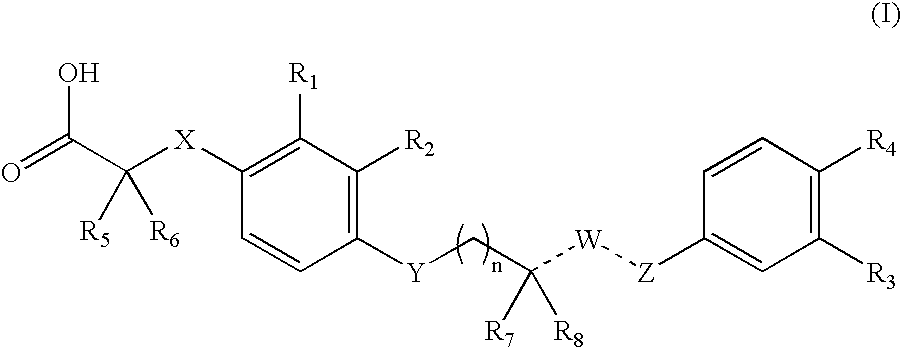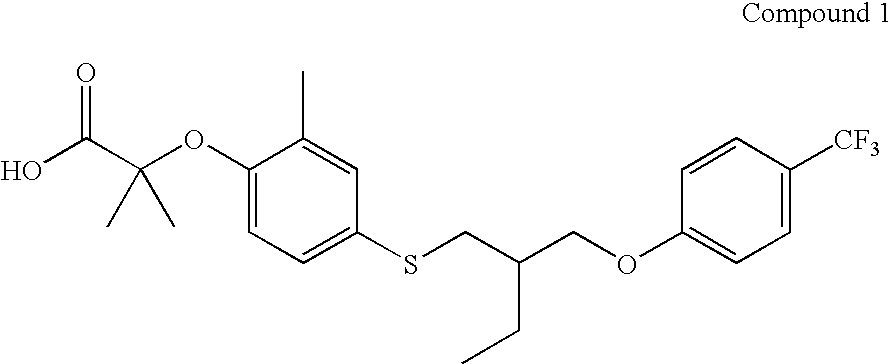4-((phenoxyalkyl)thio)-phenoxyacetic acids and analogs
a technology of phenoxyacetic acid and thiosethyl phenoxyacetic acid, which is applied in the field of 4((phenoxyalkyl) thiosethyl)phenoxyacetic acid and analogs, can solve the problems of insufficient insulin activation of glucose uptake, oxidation and storage in muscle, inadequate insulin repression of lipolysis in adipose tissue, and insufficient glucose production and secretion in liver, which
- Summary
- Abstract
- Description
- Claims
- Application Information
AI Technical Summary
Benefits of technology
Problems solved by technology
Method used
Image
Examples
example a
[0178]
{2-Methyl-4-[2-(4-trifluoromethyl-phenoxymethyl)-butylsulfanyl]-phenoxy}-acetic acid
[0179]
[0180] According to Scheme A1, to a flask containing chlorosulfonic acid (15.0 mL, 226 mmol) at 4° C. was added ethyl (2-methylphenoxy)acetate Ala (10.0 g, 51.6 mmol) slowly. The mixture was stirred at 4° C. for 30 min and room temperature for 2 h, and then poured into ice water. The precipitated white solid was filtered, washed with water, and dried under vacuum overnight to provide 14.0 g (93%) of A1b as a white solid; 1H NMR (300 MHz, CDCl3) δ 7.87-7.84 (m, 2H), 6.80 (d, J=9.5 Hz, 1H), 4.76 (s, 2H), 4.29 (q, J=7.1 Hz, 2H), 2.37 (s, 3H), 1.31 (t, J=7.1 Hz, 3H); MS (ES) m / z: 315 (M+Na+).
[0181] To a solution of A1b (4.70 g, 16.1 mmol) in EtOH (20 mL) was added a solution of 4.0 M HCl in dioxane (20 mL) followed by 100 mesh tin powder (9.80 g, 82.6 mmol) portionwise. The mixture was refluxed for 2 h, poured into CH2Cl2 / ice (100 mL), and filtered. The filtrate was separated, and the aqueo...
example b
[0187]
{4-[2-Ethoxy-3-(4-trifluoromethyl-phenoxy)-propylsulfanyl]-2-methyl-phenoxy}-acetic acid
[0188]
[0189] A mixture of 4-trifluoromethylphenol (7.80 g, 48.1 mmol), 2-chloromethyloxirane (11.2 g, 121 mmol), and Cs2CO3 (15.7 g, 48.2 mmol) in dioxane (8 mL) was refluxed for 3-4 h and then allowed to cool to room temperature. Water and Et2O were added, the organic phase was separated, and the aqueous phase was extracted with Et2O. The combined organic layers were dried, concentrated, and column chromatographed (CH2Cl2 / hexane: 1 / 1) to provide 8.40 g (80%) of B1; 1H NMR (300 MHz, CDCl3) δ7.55 (d, J=8.5 Hz, 2 H), 6.99 (d, J=8.5 Hz, 2H), 4.29 (dd, J=11.1, 3.0 Hz, 1H), 3.98 (dd, J=11.1, 5.8 Hz, 1H), 3.37 (m, 1H), 2.93 (m, 1H), 2.77 (dd, J=4.9, 2.6 Hz, 1H).
[0190] To a mixture of B1 (2.57 g, 11.8 mmol) and (4-mercapto-2-methyl-phenoxy)acetic acid ethyl ester A1c (4.00 g, 17.7 mmol) in THF (20 mL) was added 1.0 M tetrabutylammonium fluoride in THF (0.44 mL, 0.44 mmol). The reaction mixture w...
example c
[0193]
2-{2-Methyl-4-[2-(4-trifluoromethyl-phenoxymethyl)-butylsulfanyl]-phenoxy}-propionic acid
[0194]
[0195] To a solution of A2d (245 mg, 0.54 mmol) in THF (3 mL) at −78° C. was added 1 N solution of lithium bis(trimethylsilyl)amide in THF (0.54 mL, 0.54 mmol) dropwise. After 30 min, methyl trifluoromethanesulfonate (0.061 mL, 0.54 mmol) was added. The reaction mixture was allowed to warm gradually to 0° C. over 1 h, quenched with saturated aqueous NaHCO3 solution, and extracted with Et2O (×3). The extracts were dried, concentrated, and column chromatographed to provide 64.5 mg (25%) of C1; 1H NMR (300 MHz, CDCl3) δ 7.51 (d, J=8.8 Hz, 2H), 7.18 (d, J=1.8 Hz, 1H), 7.12 (dd, J=8.5, 1.8 Hz, 1H), 6.90 (d, J=8.8 Hz, 2H), 6.55 (d, J=8.5 Hz, 1H), 4.65 (q, J=6.8 Hz, 1H), 4.19 (q, J=7.1 Hz, 2H), 4.01 (m, 2H), 2.99 (d, J=6.5 Hz, 2H), 2.20 (s, 3H), 1.96 (m, 1H), 1.60 (d, J=6.8 Hz, 3H), 1.58 (m, 2H), 1.24 (t, J=6.1 Hz, 3H), 0.94 (t, J=7.5 Hz, 3H); MS (ES) m / z: 493 (M+Na+).
[0196] Compound 1 (9...
PUM
| Property | Measurement | Unit |
|---|---|---|
| density | aaaaa | aaaaa |
| temperature | aaaaa | aaaaa |
| temperature | aaaaa | aaaaa |
Abstract
Description
Claims
Application Information
 Login to View More
Login to View More - R&D
- Intellectual Property
- Life Sciences
- Materials
- Tech Scout
- Unparalleled Data Quality
- Higher Quality Content
- 60% Fewer Hallucinations
Browse by: Latest US Patents, China's latest patents, Technical Efficacy Thesaurus, Application Domain, Technology Topic, Popular Technical Reports.
© 2025 PatSnap. All rights reserved.Legal|Privacy policy|Modern Slavery Act Transparency Statement|Sitemap|About US| Contact US: help@patsnap.com



